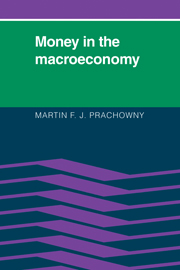Book contents
- Frontmatter
- Contents
- List of charts, figures, and tables
- Preface
- List of symbols
- 1 The roles of money and monetary policy in the macroeconomy
- 2 A model of the macroeconomy
- 3 The new classical model: the case against stabilization policy
- 4 The institutionalist model: the case for stabilization policy
- 5 The demand for money
- 6 The supply of money
- 7 The monetary mechanism
- 8 U.S. monetary policy and the dilemma of stagflation
- 9 A model of an open economy
- 10 Managed exchange rates and monetary policy
- 11 Monetary policy in Canada and its macroeconomic consequences
- 12 Improving the monetary policy apparatus
- Index
3 - The new classical model: the case against stabilization policy
Published online by Cambridge University Press: 26 October 2011
- Frontmatter
- Contents
- List of charts, figures, and tables
- Preface
- List of symbols
- 1 The roles of money and monetary policy in the macroeconomy
- 2 A model of the macroeconomy
- 3 The new classical model: the case against stabilization policy
- 4 The institutionalist model: the case for stabilization policy
- 5 The demand for money
- 6 The supply of money
- 7 The monetary mechanism
- 8 U.S. monetary policy and the dilemma of stagflation
- 9 A model of an open economy
- 10 Managed exchange rates and monetary policy
- 11 Monetary policy in Canada and its macroeconomic consequences
- 12 Improving the monetary policy apparatus
- Index
Summary
INTRODUCTION
Until recently, the IS-LM model with a positively sloped AS curve (often called the Phillips curve) would have sufficed for a thorough analysis of stabilization policy. The effect of monetary policy or fiscal policy on income, the interest rate, and the inflation rate could be calculated and a number of related issues, such as the budgetary effects of policy changes, could be discussed in great detail. But during the past decade or so, some fundamental questions about this framework have been raised that make the macroeconomist's life much more complicated, such as:
What is the goal of macroeconomic policy in the face of a self-equilibrating economy? and
What advantage does the government have over private individuals in dealing with an economy that is operating temporarily in disequilibrium?
New classical and Keynesian-oriented economists would provide different answers to these questions, but they would not disagree about the long-run version of the IS-LM-AS model and the effect of macroeconomic policies on the equilibrium position of the economy.
It is appropriate at this point to look at the names of various schools of thought in macroeconomics. The model in Chapter 2 is often called the neoclassical model because its focus is long-run equilibrium where output is supply-constrained and not demand-determined. The new classical model, to be developed in this chapter, has many of the same antecedents and present-day adherents; however, its main purpose is to show that there is little room for policy intervention even in the short run, contrary to the Keynesian model.
- Type
- Chapter
- Information
- Money in the Macroeconomy , pp. 68 - 98Publisher: Cambridge University PressPrint publication year: 1986



